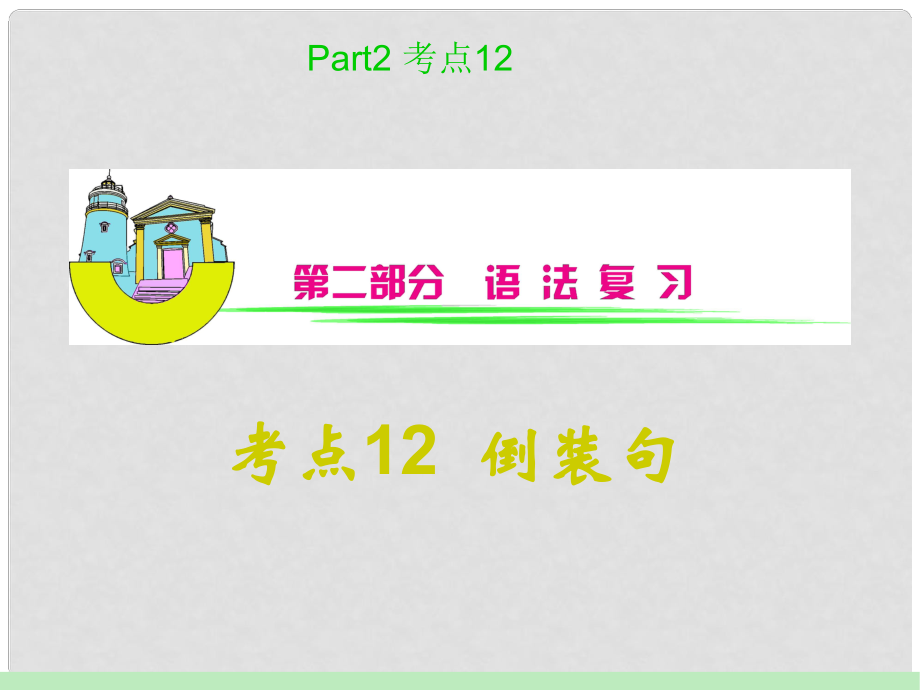《安徽省高中英語(yǔ)總復(fù)習(xí) 考點(diǎn)12倒裝句課件 北師大版 新課標(biāo)》由會(huì)員分享�,可在線閱讀,更多相關(guān)《安徽省高中英語(yǔ)總復(fù)習(xí) 考點(diǎn)12倒裝句課件 北師大版 新課標(biāo)(14頁(yè)珍藏版)》請(qǐng)?jiān)谘b配圖網(wǎng)上搜索�。
1、Part2 考點(diǎn)12考點(diǎn)考點(diǎn)12 倒裝句倒裝句1.主要考查的知識(shí)點(diǎn):(1)使用全部倒裝的情況(2)使用部分倒裝的情況2.復(fù)習(xí)重點(diǎn):引起倒裝的詞或短語(yǔ)3.應(yīng)對(duì)方法:解題時(shí)�,首先認(rèn)真分析題干句的句子,若句首含有引起倒裝的詞或短語(yǔ)�,再結(jié)合主語(yǔ)的情況判斷是否要倒裝,同時(shí)比較4個(gè)選項(xiàng),從時(shí)態(tài)�、語(yǔ)態(tài)等方面進(jìn)行判斷。 倒裝有兩種形式:一是表語(yǔ)�、狀語(yǔ)置于句首,而主語(yǔ)置于句末�,進(jìn)行完全倒裝;二是只將助動(dòng)詞�、情態(tài)動(dòng)詞等提前到主語(yǔ)的前面,進(jìn)行部分倒裝�。1完全倒裝 構(gòu)成:將謂語(yǔ)動(dòng)詞直接提到主語(yǔ)前。(1) Here comes the bus. (2) In she came.(3) South of the rive
2�、r lies a small factory.(4) Such are the facts. (5) There stands an ancient tower on the top of the mountain.(6) Present at the party were Mr. Green and many other guests. (7) Gone are the days when we used the “foreign oil”規(guī)則1:表方位的副詞here, there, out, in, up, down, away, off等放在句首,而主語(yǔ)是名詞時(shí)�,句子則完全倒裝,如:(1
3�、)。但是�,當(dāng)主語(yǔ)是人稱代詞時(shí),主謂語(yǔ)序不變�,如:(2)。 規(guī)則2:地點(diǎn)狀語(yǔ)位于句首時(shí)�,為了避免頭重腳輕,常將謂語(yǔ)置于主語(yǔ)之前�,進(jìn)行完全倒裝,如:(3)�。規(guī)則3:為了使上下文聯(lián)系緊密�,常將such, the following 放于句首�,而句子的謂語(yǔ)動(dòng)詞置于主語(yǔ)之前,進(jìn)行完全倒裝�,如:(4)。規(guī)則4:there be句型中�,用完全倒裝。此時(shí)�,結(jié)構(gòu)中的be可用lie/exist / stand / live / seem 等動(dòng)詞替代,如:(5)�。規(guī)則5:有時(shí)為了突出或強(qiáng)調(diào)主語(yǔ),可用“表語(yǔ)系動(dòng)詞主語(yǔ)”的完全倒裝結(jié)構(gòu)�,如:(6)、(7)�。2. 部分倒裝 構(gòu)成:將情態(tài)動(dòng)詞、助動(dòng)詞�、be提到主語(yǔ)前。 (1
4�、) By no means can he catch up in such a short time. (2) He is active in personality, and seldom does he stay indoors. (3) Not only children but also adults are interested in the film Harry Potter. (連接并列主語(yǔ),不可倒裝)(4) Hardly had I got to the airport when the plane took off. (5) Not until all the fish di
5�、ed in the river did the villagers realize how serious the pollution was.(6) Neither did I want to see the film nor did I buy the ticket. I neither wanted to see the film nor bought the ticket.(7) Only in this way can you learn English well. (8) Only that boy can work out the problem.(9) Were I there
6�、, they would listen to me. (10) Such a clever boy was Jack that he was able to work out all these difficult problems. (11) No matter how late it is, she often waits for him. (12) How blue the sky looks!(13) What a clever boy he is!規(guī)則1:含有否定意義的副詞或短語(yǔ),如:few, little, never, not, not until, nowhere, rarel
7�、y, seldom, hardly/scarcelywhen, no sooner(than)�, not only(but also), at no time, by no means等�,放在句首時(shí)�,句子須部分倒裝,如:(1)�。【特別提醒】若原句中沒(méi)有助動(dòng)詞�,必須根據(jù)謂語(yǔ)動(dòng)詞的具體時(shí)態(tài)來(lái)確定相應(yīng)的助動(dòng)詞do, does 或did,如:(2)�。not onlybut also連接兩個(gè)并列主語(yǔ)時(shí)不可倒裝。只有在連接兩個(gè)句子且將not only所連接的句子提到句首時(shí)�,才可用倒裝,but also后面的句子不倒裝�,如:(3)。在“hardly/scarcelywhen從句”和 “no soonerth
8�、an從句”結(jié)構(gòu)中,主句用過(guò)去完成時(shí)�,而從句用一般過(guò)去時(shí),如:(4)�。not until提前時(shí),必須同時(shí)將until后面的全部?jī)?nèi)容提前�,如:(5)。neithernor 句型中兩個(gè)句子都需要部分倒裝�。如:(6)。規(guī)則2:so/as/neither/nor 位于句首�,連接兩種相同的情況時(shí),所連接的并列分句需用部分倒裝�。規(guī)則3:“only 副詞/介詞短語(yǔ)/狀語(yǔ)從句” 放在句首時(shí)�,句子須用部分倒裝�,如:(7)?!咎貏e提醒】 only修飾主語(yǔ)時(shí),不倒裝�,如:(8)。規(guī)則4:在虛擬語(yǔ)氣條件句中�,從句謂語(yǔ)有助動(dòng)詞were, had, should時(shí),可將if 省略�,而把 were, had, should
9、移到句首�,如:(9)?!咎貏e提醒】若從句是否定句,則必須將not放在主語(yǔ)后�。had必須是助動(dòng)詞。規(guī)則5:在 “sothat” 和 “suchthat”結(jié)構(gòu)中�,將“so_adj.”和“suchn._”提到句首時(shí),句子須用部分倒裝�,如:(10)?!咀⒁狻?句子的一部分成分(通常是表語(yǔ)或狀語(yǔ))提前,但主謂語(yǔ)序不變�。1. as連接讓步狀語(yǔ)從句所引起的倒裝詳見(jiàn)考點(diǎn)10讓步狀語(yǔ)從句�。2. 否定詞no matter連接的讓步狀語(yǔ)從句的句式 “No matter how / wh 主語(yǔ) 謂語(yǔ)”�,如:(11)�。3. how和what引起的感嘆句(1) How 形容詞/副詞主語(yǔ)謂語(yǔ),如:(12)�。(2) What 形容詞名詞主語(yǔ)謂語(yǔ),如:(13)�。
 安徽省高中英語(yǔ)總復(fù)習(xí) 考點(diǎn)12倒裝句課件 北師大版 新課標(biāo)
安徽省高中英語(yǔ)總復(fù)習(xí) 考點(diǎn)12倒裝句課件 北師大版 新課標(biāo)

